Six years ago, I first heard of Nelvana of the Northern Lights, an Inuit demigoddess printed in comic books across Canada during WWII. She was a fierce protector of the North who used her superpowers to fight exploiters of the Arctic, from Nazis to interdimensional space invaders. Besides that, she was also one of the earliest comic-book SuperWomen, predating Wonder Woman by several months[1]. I’m a nerd, a feminist, and an avid fan of Arctic literature so I was incredibly shocked that I never heard of her before, and I became completely captivated. Then frustrated, as her adventures have been out of print since her last appearance in 1947[2].
Like all superheroes, Nelvana has two origins, one her canon origin, and the other her historical origin. In her stories, Nelvana is the daughter of Koliak, King of the Northern Lights, and an unnamed mortal woman. She has a brother named Tanero, a demigod who bears a curse of needing to hide his true human form from white men (indicated as ‘kablunets’[3] in the story). No mention is made of Nelvana and Tanero’s mother at any point in the 313 pages published of her adventures.

Finding her historical origin set me on a quest that took me to the northern reaches of Canada’s Arctic communities (at least via the internet!)
The first I heard about Nelvana’s true origins was taken from two interviews that her creator Adrian Dingle did in the 1970s. In the first interview, conducted with Michael Hirsh and Patrick Loubert who went on to found the animation company Nelvana, they wrote:
He (Adrian Dingle) says he was inspired to create Nelvana by stories that Franz Johnston, the Groupof Seven painter, hadbrought back with him from the Arctic. Nelvana was a “pretty gruesome character” in Eskimo legend, Dingle recalls, so he “made her into an attractive doll” by slipping herinto a miniskirt (The Great Canadian Comic Books, Peter Martin Associates, 1971).
Two years later, Canadian comic creator Dave Sim interviewed Adrian Dingle and his wife Pat for Harry Kremer’s zine Now and Then Times, later reprinted by Alter Ego:
The Nelvana strip was created from legend by Franz Johnston – the late Franz Johnston – who was a member of the Group of Seven painters. And he came back from an Arctic trip and he talked about this deific character called Nelvana. And he showed me a photograph [sic] of her. She was a horrible-looking old hag who was chewing her mukluks, just about ready for the bone yard. But the name stuck (Alter Ego #36, TwoMorrows Publishing, May 2004).
Interpreting these two interviews led me to declare that Nelvana was a deity in an Inuit legend told in oral tradition to Franz Johnston by Inuit elders and later repeated to Adrian Dingle who created a superheroine based on this legend. Finding no record of a goddess named Nelvana didn’t worry me, as reading accounts of Inuit folklore I knew that oral storytelling changes from community to community and many are never written down. This is the way I told the story for years, until a meeting in 2013 shook the very foundations of her established origin and sent me on a new quest.
It was in October 2013 that Rachel Richey and I launched a campaign to reprint Nelvana’s original comic-book adventures, and I was fortunate enough to find Adrian Dingle’s son Christopher living just a few blocks from my home in Toronto. When we met up with him, he startled us by declaring that Nelvana was not an Inuit myth. She was a real woman.
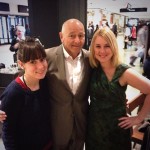
“But what my dad said was that Nelvana, the real Nelvana, was an old hag, an old woman who was perhaps a shaman, a seer, a healer, or something. But a toothless old woman certainly, in some Inuit village…And I’m sure there was alcohol involved, but they started talking about what a romantic name this was and you could see where that led to this concept of a superhero with amazing powers protecting the Canadian North (Interview with Christopher Dingle, recorded on October 22, 2013).
What an unusual twist! And yes, if we go back and read Michael Hirsh and Dave Sim’s interviews with Adrian Dingle, Adrian Dingle does not say that she is based on legend, in fact his mention of a photograph in the Dave Sim interview definitely indicates that she is a real person! It is these small interpretations that researchers make when they record history that can have a fundamental change on what the true story is.
My great-grandfather, Dr. W E Anderson, was a medical doctor in the early 1900s who travelled extensively to Inuit and First Nations communities across Canada, picking up artifacts and stories along the way. As an interesting connection, he himself was inspired by Franz Johnston in his paintings of the areas he visited, though he passed away before Nelvana was created. But conducting research on him for the Hudson’s Bay Company Archives gave me a familiarity with various areas where I could begin my hunt for the Nelvana who inspired the superhero.
My research was started off by an email sent to me by fellow Canadian comic researcher Jim Brigham, who pointed out a newspaper article that stated the area that Franz Johnston visited in his Arctic journey was Port Radium, NWT[4], the article also stated the Inuit he visited lived in a community called Coppermine.
I then ran a search on the Library and Archives Canada for the name Nelvana, and found my first evidence of her existence: A photograph of a tattooed Inuit woman named Kukilukak, listed as being Cecile Nelvana Kamingoak’s step-mother, taken in Coppermine in 1949
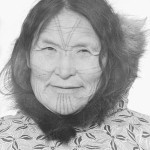
What a find! A photograph of an elder related to Nelvana taken in the region that Franz Johnston visited! But if this is Nelvana’s step-mother, Nelvana must be considerably younger, and younger still in 1939 when Franz Johnston visited. As much as I wished Kukilukak was Nelvana, there was clearly a need to dig deeper.
At this time, I was approached by journalist Samia Madwar to do an interview for the Nunavut magazine Up Here[5]. In this article I discussed my search for the real Nelvana and gave all the clues that I had put together so far. Included in the article I posted the photo of Kukilukak, hoping it would spur interest.
I had previously posted the photo on our Facebook page on October 22, 2013. On January 15, 2014, Larry Adjun and Ellie Adjun of Kugluktuk, Nunavut[6] contacted me, confirming their relationship to the woman in the photo:
Kokilokak, I’m named after her by Inuit custom of carrying on elders names, named by my grandma Nelvana as her first grandson (Larry Adjun, Facebook.com, January 15, 2014)
Nelvana is an Inuktitut (Inuit name) given at birth usually by elders of the community. It is passed down from a respected elder who has passed away or is a relative in honor of them. My Grandmother’s name was Cecile Nelvana Kamingoak. We only called her “Nelvana” or Granny (Ellie Adjun, personal correspondence, January 16, 2014).
Ah, so if Inuit custom dictates that children carry on elders names, then Cecile Nelvana must be named after an elder named Nelvana. This is the woman that I am searching for!
I threw myself into my research, reading any book with a mention of Coppermine in it, and combing through historical records looking for more information, and I found records and photographs of two women named Nelvana who lived in Coppermine in 1939. Connie Nelvana was the second woman, but like Cecile Nelvana, she was too young to be the elder that Franz Johnston had met. But it’s clear that for a small region like Coppermine, for two girls to be named after a still-living elder, she must have been quite important in her community.
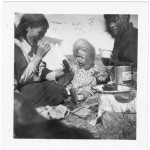
Both Connie and Cecile Nelvana were influential members of their community as well. Cecile Nelvana’s grand-daughter, Naomi Lyall, wrote me to say
My grandmother was the nicest most caring person I’ve ever known. She had over 100 grandchildren and great-grandchildren and she knew all of our names. She loved to sew and bead, everyone had a lot of her beaded flower bracelets. She was married to Peter for well over 60 years before he passed away. Every year my family would all gather in Kugluktuk for their anniversary and we had to use the community hall because there was so many of us. I believe the meaning of Nelvana is a small bird (Naomi Lyall, personal correspondence, April 2, 2014).
I found little more information about Connie Nelvana, Helen Klengenberg, a genealogist of the Coppermine area stated that she had an adopted son, and Larry Adjun let me know she lived ‘inland’, unlike most Inuit who lived on the coast or in Coppermine. She appeared to have been an artist and sculptor, and records of the area indicate that her second husband Kakik (Andy) was a trapper and hunter, with Connie being an accomplished caribou butcher. In comparison, Cecile Nelvana was married to Peter Kamingoak who was known for being an explorer and guide of the area for visitors[7] and involved in local politics.
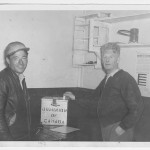
I was not able to find information on a woman named Nelvana who predated Connie or Cecile, but I was stubborn about my belief that she must exist. In my mind, it was not unusual that there was no record of her, written records of northern communities are spotty at the best of times, and if she was not Christian, there would be no record of her in many of the usual record databases such as birth, death, or marriage.
The only person known to have visited her was Franz Johnston, so I turned to researching him instead. Unfortunately, his only known biographers passed away, so I turned to hands-on research. I learned he kept a daily diary of his Arctic journey and this was available at Library and Archives Canada. My friend, John Keigher, who lives in Ottawa volunteered to go and conduct this research for me and photographed every page of Franz Johnston’s hand-written journal.
My heart rose when after hours of reading the journal I find his pages related to his stay in Coppermine (most of his journey is spent in Port Radium and Eldorado) and on April 6, 1939, the lines: “Eventually, we arrived at a sealing camp and what an experience that turned out to be.” Sadly, he did not describe the experience further, and I have yet to find a written account of the stories that he told to Adrian Dingle about the Nelvana who inspired the superhero.

Some might be disappointed in this conclusion. After all, I didn’t find the Nelvana I was searching for. Though I did not find the mother of the world’s most interesting SuperWoman, I was honoured to have met her ‘sisters’ Connie and Cecile in my research, and the community that they helped build was supportive and encouraging in my quest. Both Connie and Cecile Nelvana were role models in their community, dedicated to their families and their pursuits. My research into the community unearthed a legacy left behind that goes behind superheroes battling aliens, into a very real impact that a good person can have on their loved ones and community. I can think of no greater superpower than that.
With thanks to: Jim Brigham, Helen Klengenberg, Millie Evalik, Naomi Lyall, Larry Adjun, Elly Adjun, James Gorton, John Keigher, Robin Weber, JM Frey, Jess Thorpe, and Christopher Dingle
UPDATE – July 4, 2014
According to an article that interviewed Franz Johnston shortly upon his return to Toronto but before he met up with Adrian Dingle, Nelvana was indeed an inspiration to him. Described as a ‘pretty, Arctic Madonna’ it seems that she was likely not an elder at all! As the description of her in this article, along with the timeline, matches up to the then 16 year old Cecile Nelvana being the inspiration behind the superheroine.
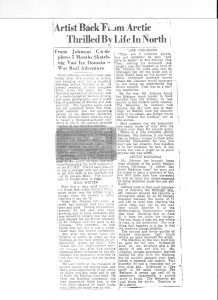
[1] Triumph-Adventure Comics #1, Hillborough Studios, August 1941
[2] Super-Duper Comics #3, Bell Features, May 1947
[3] Kablunet is Franz Johnston’s interpretation of the Inuktitut word that refers to white men, which can also have a translation of ‘men of thick eyebrows’ and be spelled alternatively as Qablunat (Tales From the Igloo, Hurtig Publishers, 1972)
[4] Ottawa Citizen, Canadian Press, July 12 1939
[5] Up Here Magazine, January 2014
[6] When Nunavut was incorporated many English names were changed to their Inuktitut versions. Kugluktuk is the modern name for Coppermine, NWT.
[7] Peter Kamingoak features prominently in the book The Face of the Arctic, Richard Harrington, 1954

